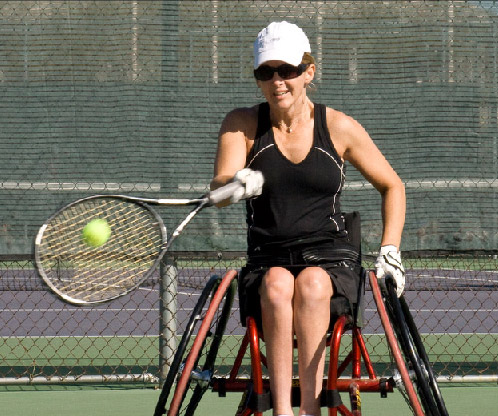
Cyndy McLean never expected to take up a new sport in her 30s — let alone one that would have her flying around the world representing Canada in international tournaments.
Then again, a lot of things have happened to McLean in the past few years that she never imagined — like surviving an 80-foot fall from the top of a cliff. She suffered a spinal cord injury in the 2003 accident and is now paraplegic.
Since then, McLean, the director of U of G’s Health and Performance Centre, has learned to expect the unexpected. So going from first picking up a racket to playing on the provincial and national wheelchair tennis teams in just a few years isn’t too hard to fathom.
McLean just returned from a tournament in New York City. Shortly before that, she was in Dallas where it was so hot and humid she suffered heat exhaustion and almost had to forfeit the match. This spring she represented Canada at the World Team Cup in Turkey, the equivalent of the Davis Cup in able-bodied tennis. She has also played in England, Italy and throughout the United States and Canada.
“It’s a lot of fun and a great way to travel.”
McLean started playing tennis as a way of getting back into sports after her injury. A former marathon runner, the idea of not having a physical outlet was unthinkable. Basketball wasn’t for her: “too fast, too many chairs on the court at once.” And competitive wheelchair racing was out of the question: “I was too old to take it up seriously.”
So she picked up a racket and started driving to Ancaster, Ont., the closest location where she could find other wheelchair tennis players. Soon she was good enough to catch the attention of provincial and national coaches.
While she loves it, it’s hard to juggle an extensive travel and practice schedule, working full-time and volunteer work. McLean is a national ambassador for the Rick Hansen Foundation and is gearing up for Guelph’s Wheels in Motion event this Sunday, June 20, a national fundraiser for spinal cord injury services and research.
Plus, she admits with a smile, it’s starting to take a toll on her body.
Tennis is a difficult sport because it requires extensive use of the dominant-side of a person’s body. It’s even harder when the player has a spinal cord injury because their mobility and range of motion is limited. McLean is paralyzed from the waist down.
Not to mention that she has two titanium rods that run parallel to her now-fused spine. “The rods jab into the muscle; that’s just the way it is. So when you play, it gets to a point where the muscle has just had it and it goes into spasms, and it’s painful.”
Women’s wheelchair tennis is also open to anyone who is unable to play able-bodied tennis. That means people with all sorts of disabilities and different athletic abilities play against each other.
For example, McLean recently competed against the number two woman in the world, a player who has a lower-leg amputation but full use of the rest of her limbs and trunk muscles. “Plus, she is six-foot-two and has a wing span the size of this room,” Mclean says with a laugh. They posed for a photo after the match. “Even with both of us sitting in chairs, there was a height difference of at least a foot.”
She says she feels like a duck out of water at times. “Tennis is such a complicated game. I miss the simplicity of running; you just put one foot in front of the other.”
Still, she is revelling in the experience and in the unexpected. Like last week in New York City. The tournament was at the Billie Jean King National Tennis Center where the U.S. Open is held. “I played in Arthur Ashe stadium, on centre court. How many people can say that? That is a big accomplishment on its own.”